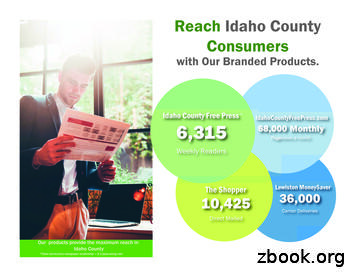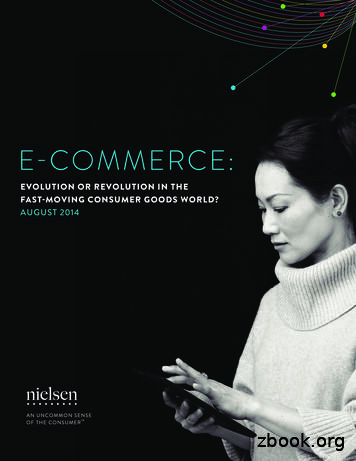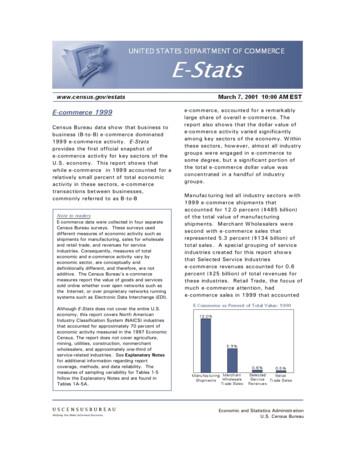Comparison Of E-commerce Products Using Web Mining
International Journal of Scientific and Research Publications, Volume 6, Issue 5, May 2016ISSN 2250-3153640Comparison of E-commerce Products using web miningRiya Shah*, Karishma Pathan**, Anand Masurkar**, Shweta Rewatkar**, Prof. (Ms.) P.N.Vengurlekar*****Department of Computer Engineering, Sinhgad Institute of Technology and Science, Savitribai Phule Pune UniversityDepartment of Computer Engineering, Sinhgad Institute of Technology and Science, Savitribai Phule Pune UniversityAbstract- Web mining is an application data-mining techniqueused to extract information from web services. E-commercewebsites nowadays have become one of the most importantsources for buying all kinds of products. Many strategies havebeen developed by analyzing customer’s behavior so as to attractmore business and participation of people. As there are many ecommerce websites available it becomes difficult for users tochoose best deal for desired product amongst these websites.Comparison of E-commerce products using web mining enablesusers to analyze prices and get desired product at minimum price.Users can also select multiple products that belong to samecategory for comparing its features. To obtain best deals from ecommerce websites web crawlers and web scrapping techniquesare used to fetch detailed information. This way, paper aims toprovide solution for online customers to buy products at gooddeal and save their valuable time, effort and money.Index Terms- web mining,MongoDB, Djangoe-commerce,webcrawler,system, Scrapping is done using python libraries like requestsand beautifulsoup4. Beautifulsoup4 is a python library which isused for parsing html pages. Using these, product informationfrom different e-commerce sites is scrapped and stored indatabase.3) MongoDB:MongoDB is classified as NoSQL database which is a documentoriented database. As system deals with large amount ofunstructured data, it is flexible to use mongodb as database. Dataextracted from scrapper is stored in MongoDB database.4) Django Web Framework:Django is a python web framework. Comparison of E-commerceproducts using web mining is product and price comparisonwebsite which is created using Django framework. Products thatare been requested by user are queried in mongodb databaseusing an object relational mapper mongoengine. Admissions inreputed varsity. Now, here we enlist the proven steps to publishthe research paper in a journal.II. SYSTEM ARCHITECTUREI. INTRODUCTIONIn the current era of online business, ecommerce have become ahuge market for the people to buy goods online .Increasing use ofsmart devices and other mediums has paved the way for users tobuy products almost from anywhere. This has increasedinvolvement of online buyers evolving e-commerce business.These large numbers of ecommerce websites put users in turmoilto search and choose to buy a single product from multipleecommerce websites .The proposed solution helps online users tograb best deal for their product from multiple ecommercewebsites on single web interface. This will in turn save userstime, money and efforts to find the same product prices ondifferent ecommerce websites. Proposed system uses webscraping technique to extract data from ecommerce web pagesand also web crawler to links for products. This will also allowusers to analyse prices and select products from same categoryfor comparing its features. This system uses the followingtechnologies:1) Web Crawler:The system deals with price comparison engine .The first thingrequired are to gather large amount of data from different ecommerce websites. It is not possible to manually collect the datafrom websites. Hence the best way is to create a web crawler thatwill navigate to these e-commerce websites. The fetched URL’sare send to scrapper for scrapping process.2) Web Scrapper:Web Scrapping is used to extract HTML data from URL’s anduse it for personal purpose. As this is price comparison website,data is scrapped from multiple e-commerce websites. In thisFigure 1 describes system architecture and its detailed workingprocedure. The front end system provides a graphical userinterface (GUI) in the form of website where clients interact withthe system whereas the backend consists of web crawling andscrapping techniques in order to extract product information fromdifferent e-commerce websites. The extracted information of ecommerce products is stored in MongoDB database .Clientrequests for desired product from main website and query is firedin local database. Product Information is displayed on main webpage. Client can see prices of required product at one placepresent on different E-commerce firms. Another feature isprovided on the website that compares products. User can addproducts of same the category to compare. User may also analyzethe product for its details and specifications.III. IMPLEMENTATIONWorking of the proposed system is as follows: The backendsystem consists of two important techniques web crawling andweb scrapping. Web scrapping is a technique that is used toextract information in the human readable format and display iton destination terminal. But before scrapping the output, WebCrawlers are responsible to navigate to the destination once thecrawler reaches the correct page and matches up with theproducts, scrapping process starts. Crawler periodically fetchesinformation from e-commerce websites so as to check forupdates .If updates are available crawlers carries those updatesand makes necessary changes in the database. Web scrappingessentially consists of two tasks: first is to load the desired webwww.ijsrp.org
International Journal of Scientific and Research Publications, Volume 6, Issue 5, May 2016ISSN 2250-3153641Figure 1. System Architecturepage and second is to parse HTML information of the page tolocate intended information. In this system Scrapping is doneusing python as it provides rich set of libraries to address thesetasks. “requests” is used to load the urls and “Beautifulsoup”library is used to parse the web page. After scrapping theproducts information from different e-commerce websites thedata is stored in MongoDB database. Using pymongoconnectivity data is scrapped and stored in database. The frondend consists of Main website. The client searches for the requiredproduct in search bar and query is fired in local database i.e.MongoDB. The website is designed using Django webframework which is written in python. Communication is donebetween python web framework and MongoDB usingMongoengine which is a python object –document-mapperworking with MongoDB. Required results are retrieved anddisplayed on Main website. The client can then compare pricesof products that are available on e-commerce websites. A soon asclient selects on best deal according to him ,he will be redirectedto the original e-commerce website .Another feature provided is,Clients can compare products that belong to same category so asto differentiate specifications and choose accordingly.specifications for maximum four products which lie under samecategory. To achieve this result web mining is done to fetch therequired product details and concept of web crawler and webscraper is used to extract information of these products availableon different ecommerce websites. System will allow users toredirect to original website of that specific product selected bythe user as a best deal. Following images show how productanalysis and comparison of e-commerce sites is done.V. CONCLUSIONComparison of E-commerce products using web mining is webbased system which will help users in decision making whilebuying products online. This website will facilitate users toanalyze prices that are present on different e-commerce shoppingwebsites so that they get to know the cheapest price of productwith best deal. The website will also have the facility ofcomparing products with all its specifications that belong to samecategory. This will surely save buyers efforts and valuable time.Ultimately, this will bring together strategies, best offers anddeals from all leading online stores and will help buyers to shoponline.IV. RESULTComparison of product prices from different ecommercewebsites and result is displayed on single web interface. Alsosystem allows user to analyze and compare productwww.ijsrp.org
International Journal of Scientific and Research Publications, Volume 6, Issue 5, May 2016ISSN 2250-3153642Image 1. Product details scrapped using web scrapperImage 2. Products are displayed on main web page as soon as client queries in search barwww.ijsrp.org
International Journal of Scientific and Research Publications, Volume 6, Issue 5, May 2016ISSN 2250-3153643Image 3. User can compare 2 or 3 productsImage 4. User can compare prices of a product that are present on different e-commerce siteswww.ijsrp.org
International Journal of Scientific and Research Publications, Volume 6, Issue 5, May 2016ISSN 2250-3153ACKNOWLEDGMENTIt gives us great opportunity in presenting the preliminary projectpaper on ‘Comparison of E-commerce products using webmining’. We sincerely express our gratitude to our internal guideProf. (Ms.).P.N.Vengurlekar for giving us all the help andguidance we needed. We are really grateful to them for their kindsupport. Their valuable suggestions were very helpful. We arealso grateful to Prof. G.S.Navale, Head of Computer EngineeringDepartment, for her indispensable support, suggestions. In theend our special thanks to Dr.S.N.Mali, Principal, who has givenus valuable teaching and guidance which has inspired us to attainnew goals.REFERENCES[1] Li Mei, Feng Cheng, “Overview of WEB Mining Technology and ItsApplication in E-commerce”, Proceedings of the 2010 IEEE 2nd InternationalConference on Computer Engineering and Technology, Vol. 7, 2010.[2] Shridevi Swami , Pujashree Vidap ,” Web Scraping Framework based onCombining Tag and Value Similarity” Proceedings of the IJCSI InternationalJournal of Computer Science Issues, Vol. 10, Issue 6, No 2, November 2013.[3] Dr. Rajendra Nath ,Khyati Chopra,” Web Crawlers: Taxonomy, Issues &Challenges” Proceedings of the International Journal of Advanced Research inComputer Science and Software Engineering , Volume 3, Issue 4, April 2013, pp.944-948.[4] Jos e Ignacio Fern andez-Villamor, Jacobo Blasco-Garc ıa, Carlos A.Iglesias, Mercedes Garijo “A Semantic Scrapping Model for Web Resources”Spain.[5] Richard K. Lomotey, Ralph Deters,” RSenter: Tool for Topics and TermsExtraction from Unstructured Data Debris”, Proceeding of the IEEE InternationalCongress on Big Data, 2013.[6] I.Kali Pradeep, I. Bhagyasri , P. Praneetha ,” E-Commerce With Backbone OfData Mining”, Proceeding of the International Journal of Engineering Research &Technology (IJERT), Vol. 2 Issue 7, July – 2013.644[7] Arvind Kumar Sharma1, P.C. Gupta,” Study & Analysis of Web ContentMining Tools to Improve Techniques of Web Data Mining” Proceeding of theInternational Journal of Advanced Research in Computer Engineering &Technology (IJARCET), Volume 1, Issue 8, October 2012.[8] Rahul Dhawani, Mrudav Shukla, Priyanka Puvar, Bhagirath Prajapati, ” ANovel Approach to Web Scraping Technology” Proceeding of the InternationalJournal of Advanced Research in Computer Science and Software Engineering,Volume 5, Issue 5, MAY 2015.[9] Rupali Arora, Rinkle Rani Aggarwal ,” Modeling and Querying Data inMongoDB” ,Proceeding of the International Journal of Scientific & EngineeringResearch, Volume 4, Issue 7, July-2013.[10] B Rama Mohan, A. Govardhan.” Online Aggregation Using MapReduce inMongoDB”, Proceeding of the International Journal of Advanced Research inComputer Science and Software Engineering, Volume 3, Issue 9, September,2013AUTHORSFirst Author- Riya Shah, BE Computer Engineering, SinhgadInstitute of Technology and Science, shahriya1995@gmail.comSecond Author- Karishma Pathan, BE Computer ,karishma.ap1609@gmail.comThird Author- Anand Masurkar, BE Computer ,anand.masurkar1819@gmail.comFourth Author- Shweta Rewatkar, BE Computer ,shweta.rewatkar2@gmail.comFifth Author- Prof. (Ms.) P.N.Vengurlekar, Assistant Professor,pooja.v.85@gmail.comCorrespondence Author-Riya Shah, shahriya1995@gmail.com, 91-8793387150www.ijsrp.org
4) Django Web Framework: Django is a python web framework. Comparison of E-commerce products using web miningis product and price comparison website which is created using Django framework. Products that are been requested by user are queried in mongodb database using an object rel
Pasadena (CA) Chamber of Commerce Paso Robles Chamber of Commerce Perris Valley Chamber of Commerce Petaluma Area Chamber of Commerce . East Haven Chamber of Commerce Fairfield Chamber of Commerce Granby Chamber of Commerce Greater Danbury Chamber of Commerce Greater Hartford BOMA
Jan 09, 2017 · Wallowa County Chamber of Commerce Chamber of Commerce in La Grande, OR Union County, Oregon Chamber of Commerce Nyssa, Oregon Chamber of Commerce Ontario, Oregon Chamber of Commerce Pendleton, Oregon Chamber of Commerce The Dalles, Oregon Chamber of Commerce Vale, Oregon Chamber of Commerce
Green Valley Sahuarita Chamber of Commerce & Visitor Center Lake Havasu Area Chamber of Commerce Marana Chamber of Commerce Mesa Chamber of Commerce Nogales-Santa Cruz County Chamber of Commerce Prescott Chamber of Commerce Prescott Valley Chamber of Commerce Queen Creek
Introduction to e-commerce 1 LEARNING OBJECTIVES c To understand the complexity of e-commerce and its many facets. c To explore how e-business and e-commerce fit together. c To identify the impact of e-commerce. c To recognise the benefits and limitations of e-commerce. c To use classification frameworks for analysing e-commerce.
1.3 Various applications of E-commerce 1.4 Features of E-commerce Technology 1.5 Types of e-commerce 1.6 Impact of e-commerce 1.7 Summary 1.8 Self-Assessment Test 1.9 Suggested Readings 1.1 Introduction E-commerce is buying and selling goods and services over the Internet or doing business online. Commerce is part of e-business as specified in .
M-commerce is the next revolutionary way of doing business after e-commerce, which is set to change the landscape of businesses. The term m-commerce came into existence in 1997 when it was first used by Kevin Duffey at the launch of the Global Mobile Commerce Forum organised in the UK, to mean "the delivery of electronic
E-COMMERCE SHIFTS INTO HIGHER GEAR E-commerce is big business and getting bigger every day. Growth estimates from eMarketer report that business-to-consumer (B2C) e-commerce sales worldwide will reach 1.5 trillion in 2014, increasing nearly 20% over 2013. But not all e-commerce categories are created equal. The most popular e-commerce .
e-commerce activity for key sectors of the U.S. economy. This report shows that while e-commerce in 1999 accounted for a relatively small percent of total economic activity in these sectors, e-commerce transactions between businesses, commonly referred to as B-to-B e-commerce, accounted for a remarkably large share of overall e-commerce. The























